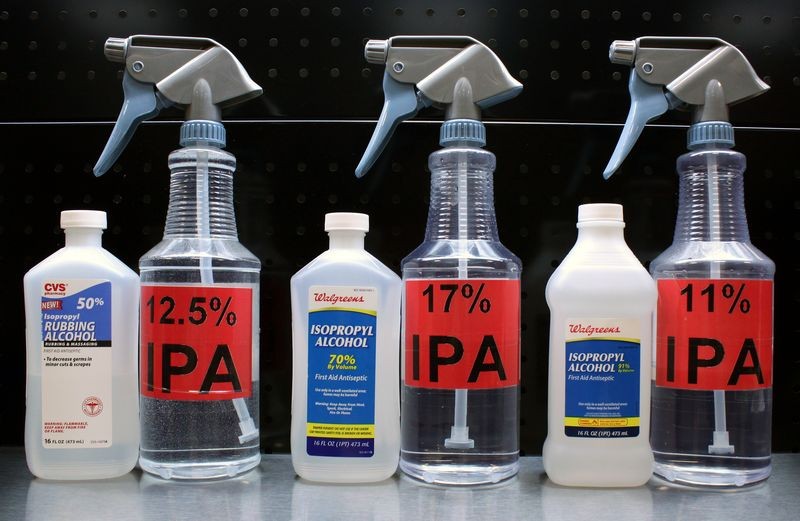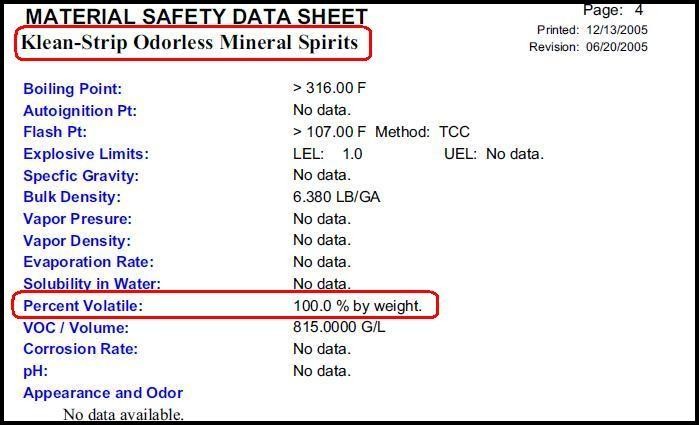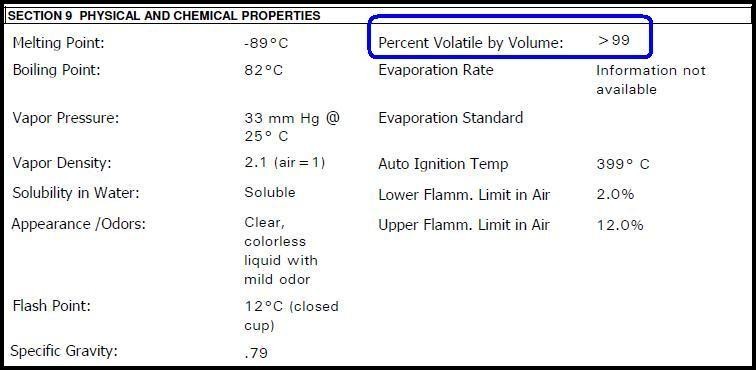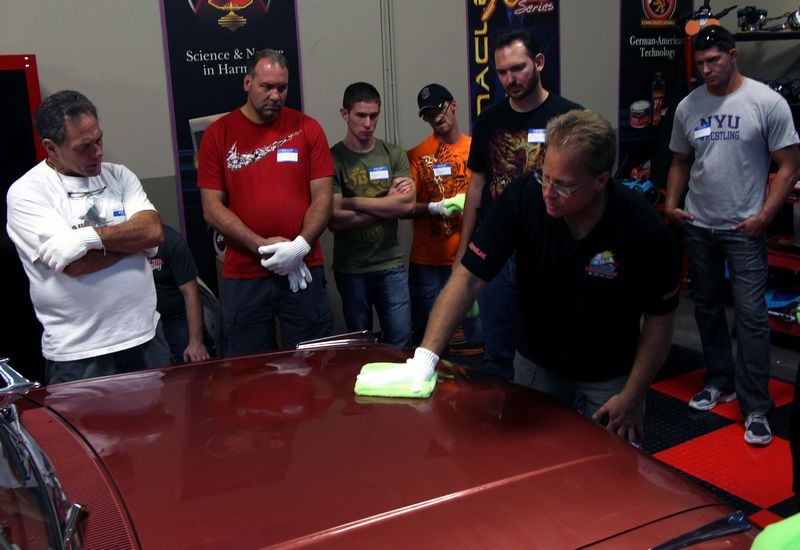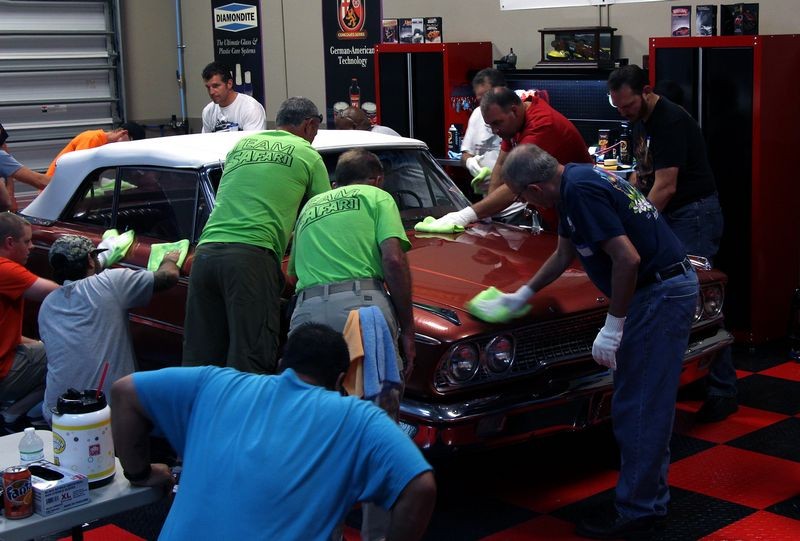How to Mix IPA for Inspecting Correction Results
WARNING
Do not chemically strip FRESH PAINT. Fresh paint has not fully cross-linked, dried and hardened. Introducing any type of solvent to the surface and allowing it to dwell could have a negative effect on the paint.
Note: The below article is NOT an official recommendation by Mike Phillips or Autogeek. It is an attempt to clear up any confusion on the topic of chemically stripping paint with the common products used for this procedure as discussed on detailing discussion forums. If you choose to chemically strip your car's paint, or your customer's car paint, all the risk is yours. Anytime you use a new product or procedure, it's a great idea to first test in an inconspicuous area and check the results before moving forward.
Common, easily found options for Isopropyl Alcohol also called IPA
![Image]()
How to Mix IPA for Inspecting Correction Results
Here are the easiest ways to mix an approximate 10% solution for the most popular concentrations of Isopropyl Alcohol available at the retail level.
91% IPA
To mix a 32 ounce Spray Bottle
Pour 4 ounces or ¼ of a 16 ounce bottle of 91% IPA into a 32 ounce spray bottle and top the rest of the bottle off with water. This will make 32 ounces at 11.375% IPA to Water solution.
70% IPA
To mix a 32 ounce Spray Bottle
8 ounces (or ½ of a 16 ounce bottle) will make 32 ounce of 17.5% IPA to Water solution. Get a 32 ounce container, pour in 8 ounces, (or ½ of a 16 ounce bottle) of the 70% IPA and then fill the rest of the container up with water and you get 32 ounces of 17.5% IPA to Water solution.
50% IPA
To mix a 32 ounce Spray Bottle
8 ounces, (or ½ of a 16 ounce bottle) will make 32 ounces of 12.5% IPA to Water solution. Get a 32 ounce container and pour in 8 ounces, (or ½ of a 16 ounce bottle) of the 50% IPA then fill the container up with water and you get 32 ounces of 12.5% solution.
Why dilute concentrated IPA to an approximate 10% IPA to Water Solution
The most common dilution levels you can purchase over the counter are 70% and 91% Isopropyl Alcohol, sometimes you can find 50% version. At the time I'm writing this article, there are no other articles on this topic to give people a general guideline as to how to dilute and use Isopropyl Alcohol to chemically strip paint. I actually made a post to an AG forum thread where I encouraged someone else to write this article, but to date there's been no takers, so here's my offering.
Most of what I've read are forum members recommending one of two options,
Most recommendations I've read are:
Their recommendation was for approximately a 10% dilution of IPA to water solution. The reason for this recommendation besides their chemistry background, is that a strong solution of IPA can stain and even soften some clear coat paints.
High Solids Clear Coats paints are "Alcohol Friendly", meaning products like Isopropyl Alcohol, can and will penetrated into, soften, wrinkle and/or stain the paint. To avoid any of these problems, a 10% dilution of IPA to water solution is recommended and adequate to remove any compounding and polishing residues without risking any danger to your car's paint or your customer's car's paint.
Another colleague in the industry coined the term Hot to describe strong solutions of Isopropyl Alcohol used to chemically strip paint.
My colleague agrees with my chemist friends that 50%, 70% and 91% dilution levels are all too strong to safely use to chemically strip paint. This person's recommendation was to stay at or below 25% dilution of IPA to water solution.
For what it's worth...
Pump spray Glass Cleaners have been used for years as a convenient way to strip the finish to inspect correction results, often times because it's a commonly found product in a detailing environment. Most glass cleaners that use alcohol are around the 10% range or lower.
In the last year, I used some 70% IPA to chemically strip paint while doing some polish comparison testing, and where I had used painter's tape to tape off specific sections for the test, after wiping the area with straight 70% IPA, some of the IPA penetrated between the tape and the paint and dwelled there while I continued testing. When I removed the tape, there was a visible place where the clear coat paint wrinkled-up from too long of exposure to the high concentration of IPA.
In hindsight I should have taken a picture, but I didn't and instead carefully sanded and removed the wrinkle-effect. I did make a post about the experience in an effort to warn others. Here's what I wrote,
If you want to chemically strip paint to remove any compound or polish residues so that you can accurately see the true condition of the paint after any correction steps, then I recommend using approximately a 10% dilution of IPA to water solution. This is a safe approach to remove any residues masking the true results of your process to the paint without the risk of causing any harm.
You can also opt to use Mineral Spirits instead as they will also remove compounding and polish residues.
Checking Your Test Spot vs Checking the Entire Car
Theoretically, if your use IPA to chemically strip your Test Spot and after stripping and inspecting the results look good to your eyes, then theoretically if you duplicate the same correction process over the rest of the panels you will also remove all the defects and leave the same finish behind that you saw in your Test Spot.
Assuming all the panels have the same type of paint, then you shouldn't have to continue stripping all the paint on each panel, just keep doing the same good work you did for your test spot and trust in your skills and ability.
You can check each square inch as you work around the car to make sure you're doing as good of work over the rest of the car as you did in your test spot, that's an option and choice each person can make. I tend to check my Test Spot and if it looks good then simply repeat the process over the rest of the car and trust in my skill and ability to duplicate my process over and over again with little variation.
Chemically Removing Waxes and/or Paint Sealants
Note this article is addressing the dilution strength for removing compounding and/or polishing lubricating oils sometimes called fillers during the paint correction steps. You can also use this to try to remove any previously applied wax or paint sealant, but while I was speaking with one of my chemists friends about this topic they told me that Isopropyl Alcohol is not effective at removing some polymer products.
Since there's no way of knowing at the molecular level what's on the surface before you wipe, and no way of knowing if 100% of everything has been removed off the surface after you wipe, therefore there's no way of knowing if IPA, (in any form) is effectively removing 100% of any previously applied wax or paint sealant. You can hope... you can assume... but you can't know 100%
If you're dead set on removing any previously applied wax or paint sealant by chemically stripping the paint, then a combination of using both a 10% solution of IPA to Water followed by wiping with Mineral Spirits should remove most, if not all, of any previously applied wax or paint sealant.
Personal Recommendation For Removing Waxes and Paint Sealants
To remove any previously applied wax or paint sealant, I recommend using a light paint cleaner or a light polish applied by hand or machine. A light paint cleaner or abrasive polish will effectively remove any previously applied wax or paint sealant AND leave the paint looking clear and glossy. I call this working forward in the process because the goal is to create beauty.
Chemically stripping the paint will tend to dull the paint; it certainly doesn't increase gloss and clarity. You don't see the dulling effect unless you're working on black paint and repeat the process multiple times. Since not everyone works on black paint, and you're not going to make stripping your car's paint a daily routine, it could be you won't see the dulling effect on your car's paint but it does take place.
Wiping a clear coated black finish over and over and over again with any type of solvent isn't going to make the top clear layer of paint more and more clear, it's going to do the opposite, that is dull it down.
So chemically stripping paint is what I call working backwards in the process. I, personally, prefer to work forwards in all my detailing projects but do understand the reasons why some people want to chemically strip their car's paint, or their customer's car's paint, and each person can decide what the best approach is for their needs.
And again, since you're not chemically stripping the paint as a "practice" but only during a detailing session, the dulling effect is not an issue, but I wanted to point it out just for the most detail oriented detailing enthusiasts or Pro Detailers reading this article.
How to safely mix different solutions of Isopropyl Alcohol to water solutions
First, if you want to be exact or close to it, then confirm the size of your secondary spray bottle and the total volume of liquid it will hold. Bottles vary from manufacturer to manufacturer and sometimes a bottle rated for 32 ounces may actually hold more than 32 ounces.
For this article, we are using the Autogeek 32 ounce Heavy Duty PVC Clear Spray Bottles. To verify the total volume of liquid they will hold, I measured out 32 ounces of water into the bottle. You can see in the pictures below that 32 ounces almost fills the bottle to the top with some breathing room for the suction tube that attaches to the spray head.
Autogeek 32 ounce Heavy Duty PVC Clear Spray Bottle
![Image]()
![Image]()
Now that we've confirmed the total volume of liquid our spray bottle holds, let's take a look at how to properly dilute the commonly available dilution strengths of over-the-counter bottles of Isopropyl Alcohol to water.
91% IPA
To mix a 32 ounce Spray Bottle
Pour 4 ounces, (or ¼ of a 16 ounce bottle), of 91% IPA into a 32 ounce spray bottle and top the rest of the bottle off with water. This will make 32 ounces at 11.375% IPA to Water solution.
![Image]()
Measure out 4 ounces of 91% IPA
![Image]()
![Image]()
Add to your clean 32 ounce spray bottle
![Image]()
We are now ready to fill the remainder of the spray bottle with water
![Image]()
Fill the remainder of the bottle with a clean water source. You can as an option used distilled or purified water.
![Image]()
Here is a properly mixed bottle of IPA diluted to approximately 11%
![Image]()
If a little is good... more is better...
I know there are some people that will want a stronger solution of IPA to water ratio and it just so happens that the 70% Isopropyl Alcohol commonly found at the retail level is easily diluted for a stronger mixture than the 11% shown above.
70% IPA
To mix a 32 ounce Spray Bottle
8 ounce (or ½ of a 16 ounce bottle) will make 32 ounce of 17.5% IPA to Water solution. Get a 32 ounce container, pour in 8 ounces, (or ½ of a 16 ounce bottle) of the 70% IPA and then fill the rest of the container up with water and you get 32 ounces of 17.5% IPA to Water solution.
![Image]()
Measure out 8 ounces of 70% IPA
![Image]()
![Image]()
Add to your clean spray bottle
![Image]()
We are now ready to fill the remainder of the spray bottle with water
![Image]()
You can as an option used distilled or purified water.
![Image]()
50% IPA
To mix a 32 ounce Spray Bottle
8 ounces, (or ½ of a 16 ounce bottle) will make 32 ounces of 12.5% IPA to Water solution. Get a 32 ounce container and pour in 8 ounces, (or ½ of a 16 ounce bottle) of the 50% IPA then fill the container up with water and you get 32 ounces of 12.5% solution.
![Image]()
Measure out 8 ounces of 50% IPA
![Image]()
![Image]()
Add to your clean 32 ounce spray bottle
![Image]()
Now fill the remainder of the bottle with a clean water source.
![Image]()
You can as an option used distilled or purified water.
![Image]()
There you have three ways to mix IPA with Water to create your choice in the level of IPA to water solution using commonly found over-the-counter bottles of Isopropyl Alcohol.
![Image]()

WARNING
Do not chemically strip FRESH PAINT. Fresh paint has not fully cross-linked, dried and hardened. Introducing any type of solvent to the surface and allowing it to dwell could have a negative effect on the paint.
Note: The below article is NOT an official recommendation by Mike Phillips or Autogeek. It is an attempt to clear up any confusion on the topic of chemically stripping paint with the common products used for this procedure as discussed on detailing discussion forums. If you choose to chemically strip your car's paint, or your customer's car paint, all the risk is yours. Anytime you use a new product or procedure, it's a great idea to first test in an inconspicuous area and check the results before moving forward.
Common, easily found options for Isopropyl Alcohol also called IPA
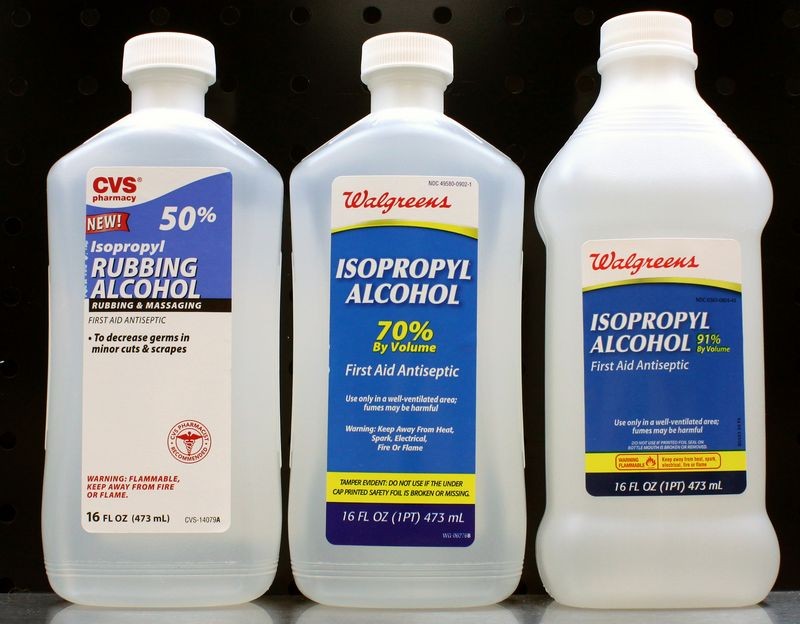
How to Mix IPA for Inspecting Correction Results
Here are the easiest ways to mix an approximate 10% solution for the most popular concentrations of Isopropyl Alcohol available at the retail level.
91% IPA
To mix a 32 ounce Spray Bottle
Pour 4 ounces or ¼ of a 16 ounce bottle of 91% IPA into a 32 ounce spray bottle and top the rest of the bottle off with water. This will make 32 ounces at 11.375% IPA to Water solution.
70% IPA
To mix a 32 ounce Spray Bottle
8 ounces (or ½ of a 16 ounce bottle) will make 32 ounce of 17.5% IPA to Water solution. Get a 32 ounce container, pour in 8 ounces, (or ½ of a 16 ounce bottle) of the 70% IPA and then fill the rest of the container up with water and you get 32 ounces of 17.5% IPA to Water solution.
50% IPA
To mix a 32 ounce Spray Bottle
8 ounces, (or ½ of a 16 ounce bottle) will make 32 ounces of 12.5% IPA to Water solution. Get a 32 ounce container and pour in 8 ounces, (or ½ of a 16 ounce bottle) of the 50% IPA then fill the container up with water and you get 32 ounces of 12.5% solution.
Why dilute concentrated IPA to an approximate 10% IPA to Water Solution
The most common dilution levels you can purchase over the counter are 70% and 91% Isopropyl Alcohol, sometimes you can find 50% version. At the time I'm writing this article, there are no other articles on this topic to give people a general guideline as to how to dilute and use Isopropyl Alcohol to chemically strip paint. I actually made a post to an AG forum thread where I encouraged someone else to write this article, but to date there's been no takers, so here's my offering.
Most of what I've read are forum members recommending one of two options,
- Dilute IPA by 50% with water or 1:1
- Use it straight out of the bottle
Dilute IPA by 50% with water or 1:1
After talking to my chemist friends, they all felt that these dilution levels were overkill and too strong for removing residues after compounding and/or polishing paint. Most quality name brand compounds and polishes are water soluble and don't need a strong solution of Isopropyl Alcohol to dissolve, emulsify and loosen any leftover residues on the surface.- Diluting 91% IPA 1:1 or by 50% with water would give you approximately a 45% dilution of IPA to water solution.
- Diluting 70% IPA 1:1 or by 50% with water would give you approximately a 35% dilution of IPA to water solution.
- Diluting 50% IPA 1:1 or by 50% with water would give you approximately a 25% dilution of IPA to water solution.
Their recommendation was for approximately a 10% dilution of IPA to water solution. The reason for this recommendation besides their chemistry background, is that a strong solution of IPA can stain and even soften some clear coat paints.
High Solids Clear Coats paints are "Alcohol Friendly", meaning products like Isopropyl Alcohol, can and will penetrated into, soften, wrinkle and/or stain the paint. To avoid any of these problems, a 10% dilution of IPA to water solution is recommended and adequate to remove any compounding and polishing residues without risking any danger to your car's paint or your customer's car's paint.
Another colleague in the industry coined the term Hot to describe strong solutions of Isopropyl Alcohol used to chemically strip paint.
Full strength IPA is a HOT chemical stripper, the stronger the ratio, the hotter it is.
My colleague agrees with my chemist friends that 50%, 70% and 91% dilution levels are all too strong to safely use to chemically strip paint. This person's recommendation was to stay at or below 25% dilution of IPA to water solution.
For what it's worth...
Pump spray Glass Cleaners have been used for years as a convenient way to strip the finish to inspect correction results, often times because it's a commonly found product in a detailing environment. Most glass cleaners that use alcohol are around the 10% range or lower.
Use it straight out of the bottle
I'm guilty of using IPA straight out of the bottle at all dilution levels, that's because I'm not a chemist, and until I wrote this article and starting speaking with real chemists about this topic, I didn't know the risks involved.
Forum Member Recommendations
Not only have I made the mistake of using IPA straight out of the bottle, I've seen well intentioned forum members on multiple, multiple forums recommend this same practice. I'll step out on a limb here and propose that like me, a lot of forum members are not chemist and have not performed any in-depth research into this topic and their recommendation is just their personal opinion or they are parroting something they read posted by some other forum member that has also likely not performed any in-depth research into this topic.
I don't want to ruffle any feathers, step on any toes or tell anyone they're wrong, so I'm just going to let the information I've shared in this article stand on its own. You, as the reader, can follow the recommendations I've presented or use Isopropyl Alcohol straight out of the bottle. It's your car, (or your customer's car), so do your own research, come to your own conclusion and then do as you will.
My comments...I'm guilty of using IPA straight out of the bottle at all dilution levels, that's because I'm not a chemist, and until I wrote this article and starting speaking with real chemists about this topic, I didn't know the risks involved.
Forum Member Recommendations
Not only have I made the mistake of using IPA straight out of the bottle, I've seen well intentioned forum members on multiple, multiple forums recommend this same practice. I'll step out on a limb here and propose that like me, a lot of forum members are not chemist and have not performed any in-depth research into this topic and their recommendation is just their personal opinion or they are parroting something they read posted by some other forum member that has also likely not performed any in-depth research into this topic.
I don't want to ruffle any feathers, step on any toes or tell anyone they're wrong, so I'm just going to let the information I've shared in this article stand on its own. You, as the reader, can follow the recommendations I've presented or use Isopropyl Alcohol straight out of the bottle. It's your car, (or your customer's car), so do your own research, come to your own conclusion and then do as you will.
In the last year, I used some 70% IPA to chemically strip paint while doing some polish comparison testing, and where I had used painter's tape to tape off specific sections for the test, after wiping the area with straight 70% IPA, some of the IPA penetrated between the tape and the paint and dwelled there while I continued testing. When I removed the tape, there was a visible place where the clear coat paint wrinkled-up from too long of exposure to the high concentration of IPA.
In hindsight I should have taken a picture, but I didn't and instead carefully sanded and removed the wrinkle-effect. I did make a post about the experience in an effort to warn others. Here's what I wrote,
Personal Recommendation For IPAMike Phillips said:
If you want to chemically strip paint to remove any compound or polish residues so that you can accurately see the true condition of the paint after any correction steps, then I recommend using approximately a 10% dilution of IPA to water solution. This is a safe approach to remove any residues masking the true results of your process to the paint without the risk of causing any harm.
You can also opt to use Mineral Spirits instead as they will also remove compounding and polish residues.
Checking Your Test Spot vs Checking the Entire Car
Theoretically, if your use IPA to chemically strip your Test Spot and after stripping and inspecting the results look good to your eyes, then theoretically if you duplicate the same correction process over the rest of the panels you will also remove all the defects and leave the same finish behind that you saw in your Test Spot.
Assuming all the panels have the same type of paint, then you shouldn't have to continue stripping all the paint on each panel, just keep doing the same good work you did for your test spot and trust in your skills and ability.
You can check each square inch as you work around the car to make sure you're doing as good of work over the rest of the car as you did in your test spot, that's an option and choice each person can make. I tend to check my Test Spot and if it looks good then simply repeat the process over the rest of the car and trust in my skill and ability to duplicate my process over and over again with little variation.
Chemically Removing Waxes and/or Paint Sealants
Note this article is addressing the dilution strength for removing compounding and/or polishing lubricating oils sometimes called fillers during the paint correction steps. You can also use this to try to remove any previously applied wax or paint sealant, but while I was speaking with one of my chemists friends about this topic they told me that Isopropyl Alcohol is not effective at removing some polymer products.
Since there's no way of knowing at the molecular level what's on the surface before you wipe, and no way of knowing if 100% of everything has been removed off the surface after you wipe, therefore there's no way of knowing if IPA, (in any form) is effectively removing 100% of any previously applied wax or paint sealant. You can hope... you can assume... but you can't know 100%
If you're dead set on removing any previously applied wax or paint sealant by chemically stripping the paint, then a combination of using both a 10% solution of IPA to Water followed by wiping with Mineral Spirits should remove most, if not all, of any previously applied wax or paint sealant.
Personal Recommendation For Removing Waxes and Paint Sealants
To remove any previously applied wax or paint sealant, I recommend using a light paint cleaner or a light polish applied by hand or machine. A light paint cleaner or abrasive polish will effectively remove any previously applied wax or paint sealant AND leave the paint looking clear and glossy. I call this working forward in the process because the goal is to create beauty.
Chemically stripping the paint will tend to dull the paint; it certainly doesn't increase gloss and clarity. You don't see the dulling effect unless you're working on black paint and repeat the process multiple times. Since not everyone works on black paint, and you're not going to make stripping your car's paint a daily routine, it could be you won't see the dulling effect on your car's paint but it does take place.
Wiping a clear coated black finish over and over and over again with any type of solvent isn't going to make the top clear layer of paint more and more clear, it's going to do the opposite, that is dull it down.
So chemically stripping paint is what I call working backwards in the process. I, personally, prefer to work forwards in all my detailing projects but do understand the reasons why some people want to chemically strip their car's paint, or their customer's car's paint, and each person can decide what the best approach is for their needs.
And again, since you're not chemically stripping the paint as a "practice" but only during a detailing session, the dulling effect is not an issue, but I wanted to point it out just for the most detail oriented detailing enthusiasts or Pro Detailers reading this article.
How to safely mix different solutions of Isopropyl Alcohol to water solutions
First, if you want to be exact or close to it, then confirm the size of your secondary spray bottle and the total volume of liquid it will hold. Bottles vary from manufacturer to manufacturer and sometimes a bottle rated for 32 ounces may actually hold more than 32 ounces.
For this article, we are using the Autogeek 32 ounce Heavy Duty PVC Clear Spray Bottles. To verify the total volume of liquid they will hold, I measured out 32 ounces of water into the bottle. You can see in the pictures below that 32 ounces almost fills the bottle to the top with some breathing room for the suction tube that attaches to the spray head.
Autogeek 32 ounce Heavy Duty PVC Clear Spray Bottle
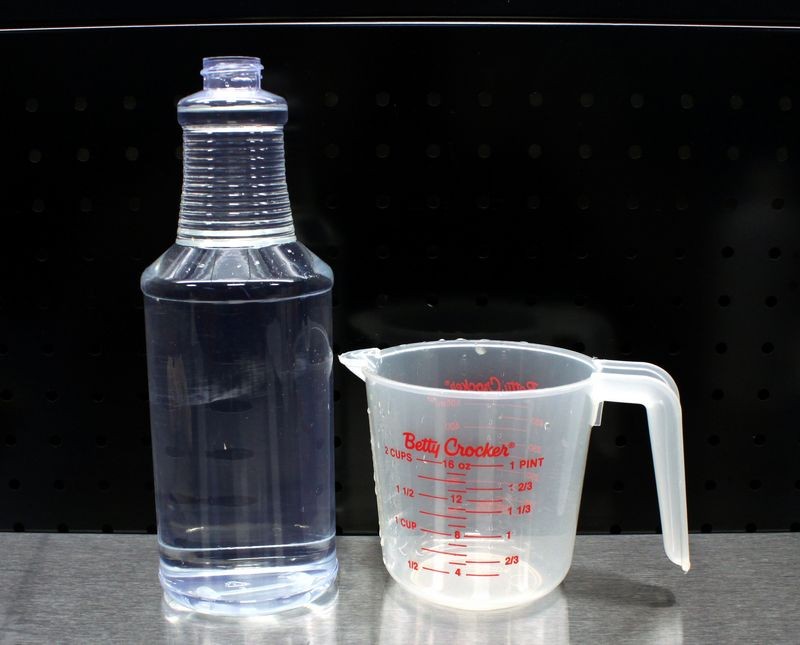
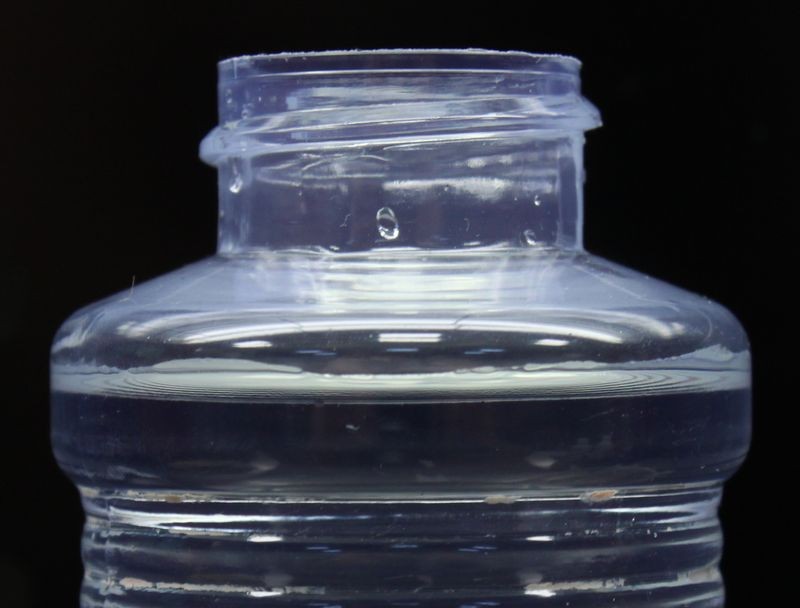
Now that we've confirmed the total volume of liquid our spray bottle holds, let's take a look at how to properly dilute the commonly available dilution strengths of over-the-counter bottles of Isopropyl Alcohol to water.
91% IPA
To mix a 32 ounce Spray Bottle
Pour 4 ounces, (or ¼ of a 16 ounce bottle), of 91% IPA into a 32 ounce spray bottle and top the rest of the bottle off with water. This will make 32 ounces at 11.375% IPA to Water solution.

Measure out 4 ounces of 91% IPA
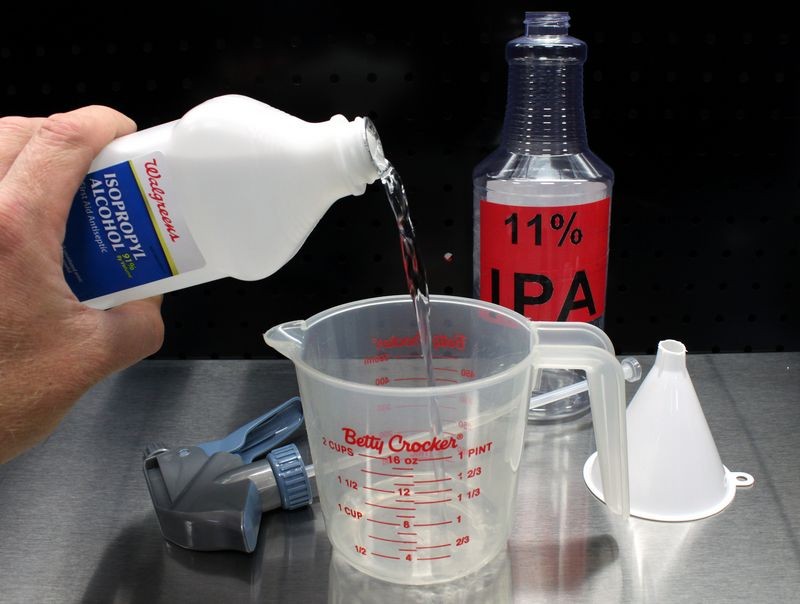

Add to your clean 32 ounce spray bottle
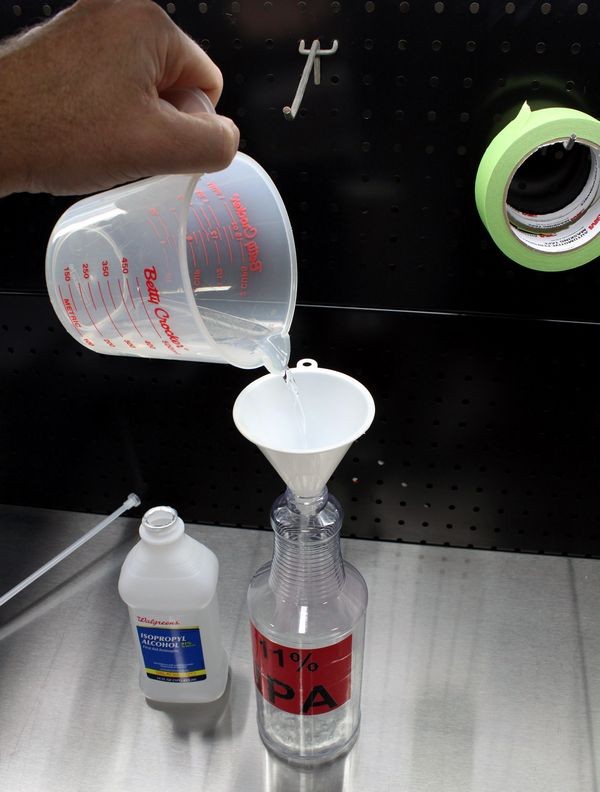
We are now ready to fill the remainder of the spray bottle with water
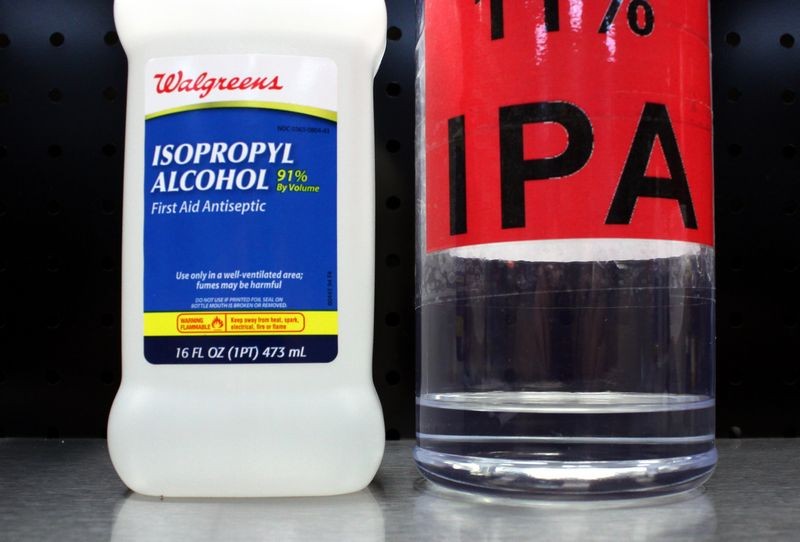
Fill the remainder of the bottle with a clean water source. You can as an option used distilled or purified water.
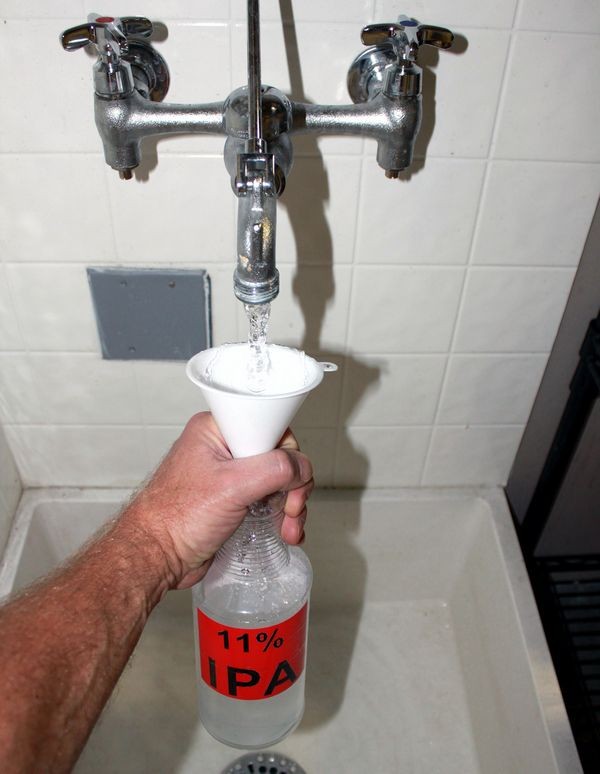
Here is a properly mixed bottle of IPA diluted to approximately 11%
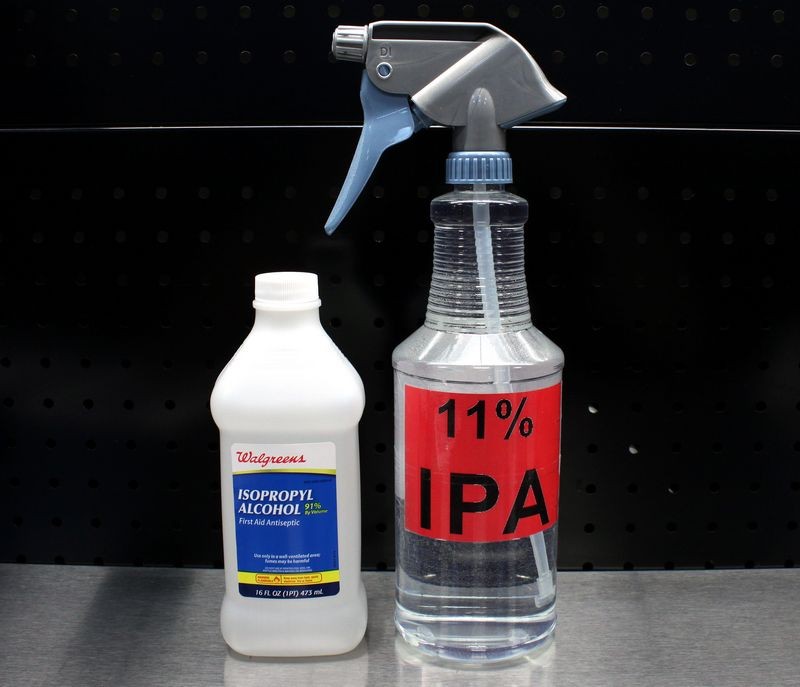
If a little is good... more is better...
I know there are some people that will want a stronger solution of IPA to water ratio and it just so happens that the 70% Isopropyl Alcohol commonly found at the retail level is easily diluted for a stronger mixture than the 11% shown above.
70% IPA
To mix a 32 ounce Spray Bottle
8 ounce (or ½ of a 16 ounce bottle) will make 32 ounce of 17.5% IPA to Water solution. Get a 32 ounce container, pour in 8 ounces, (or ½ of a 16 ounce bottle) of the 70% IPA and then fill the rest of the container up with water and you get 32 ounces of 17.5% IPA to Water solution.
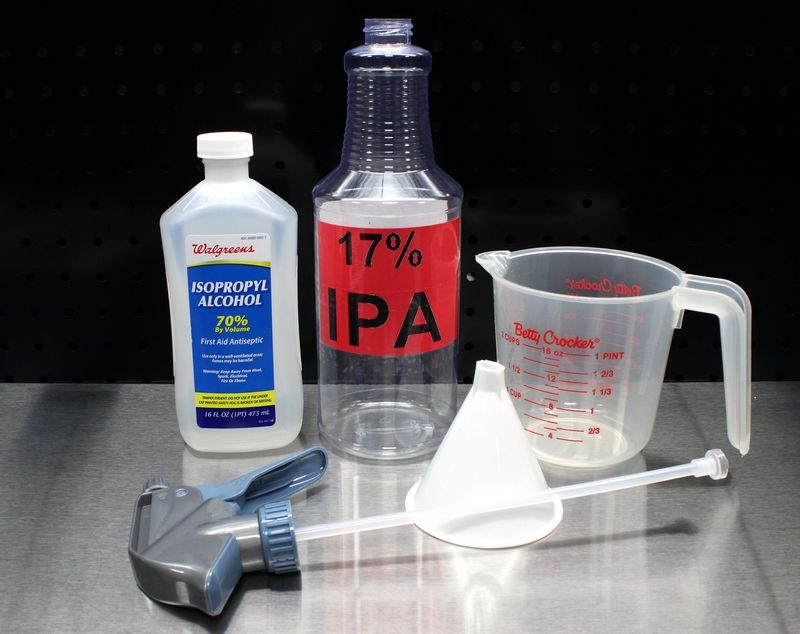
Measure out 8 ounces of 70% IPA

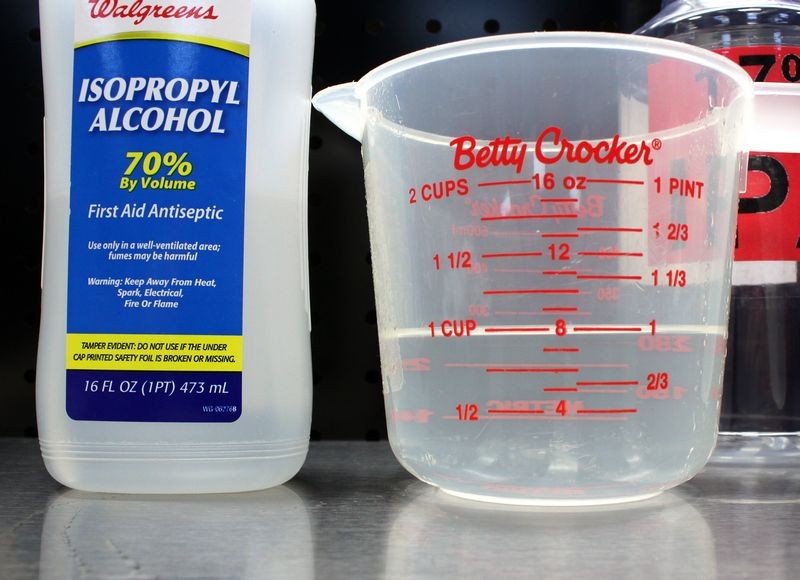
Add to your clean spray bottle

We are now ready to fill the remainder of the spray bottle with water
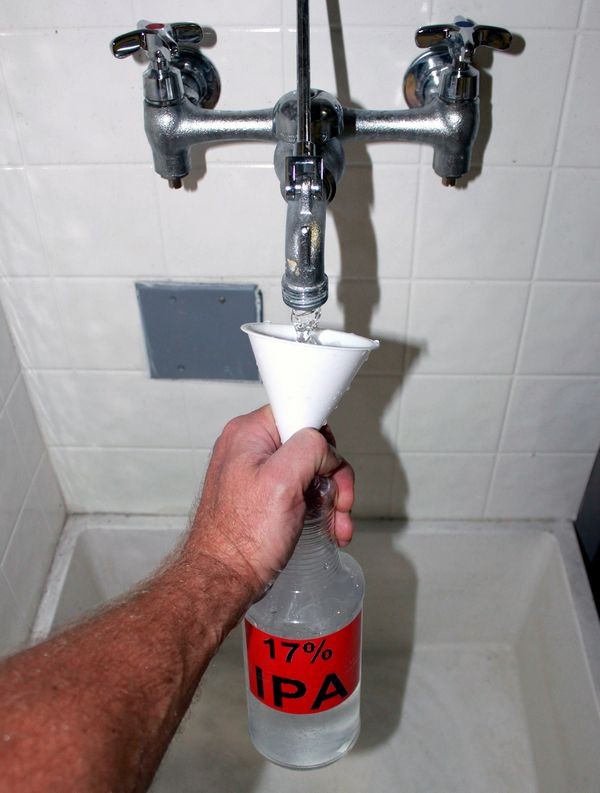
You can as an option used distilled or purified water.

50% IPA
To mix a 32 ounce Spray Bottle
8 ounces, (or ½ of a 16 ounce bottle) will make 32 ounces of 12.5% IPA to Water solution. Get a 32 ounce container and pour in 8 ounces, (or ½ of a 16 ounce bottle) of the 50% IPA then fill the container up with water and you get 32 ounces of 12.5% solution.
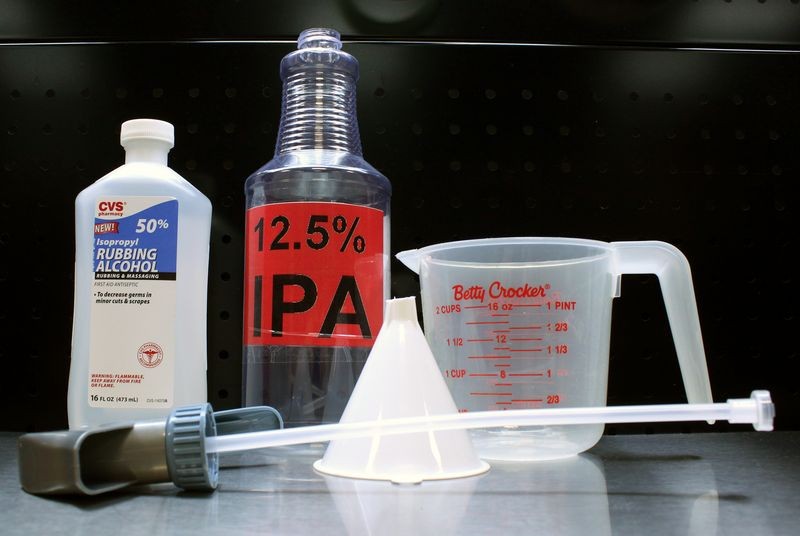
Measure out 8 ounces of 50% IPA

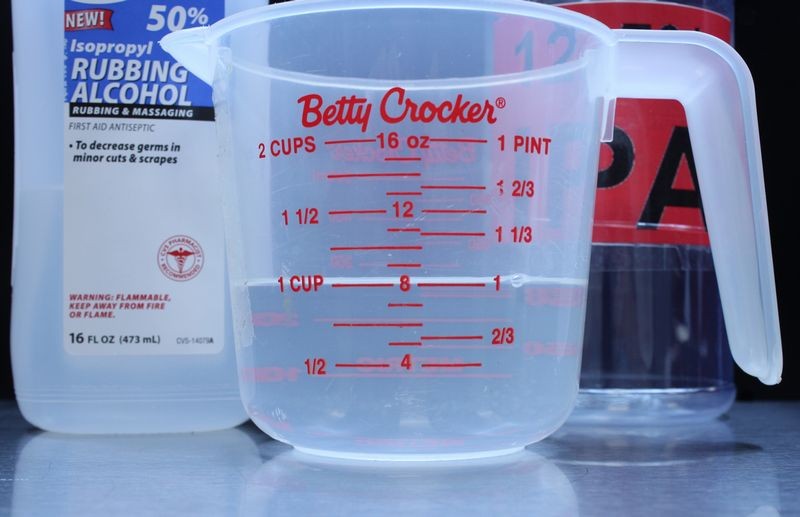
Add to your clean 32 ounce spray bottle
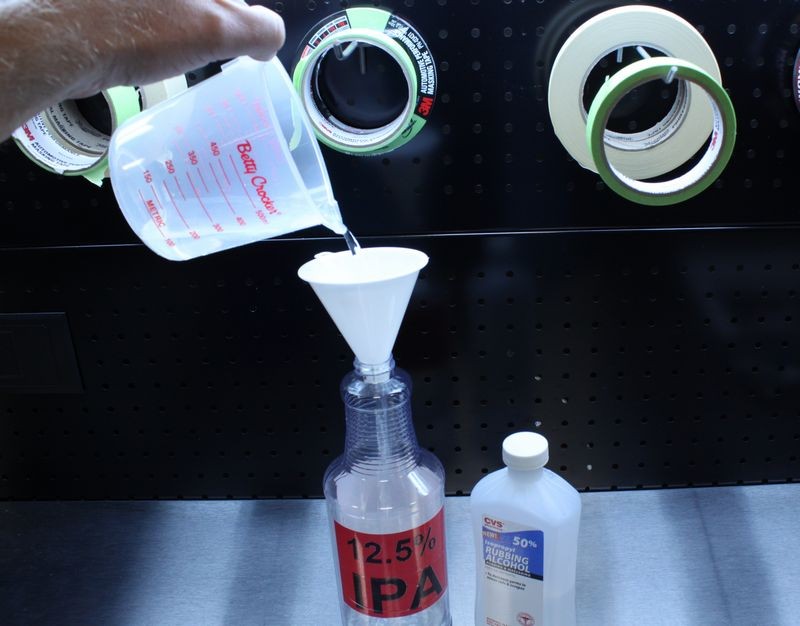
Now fill the remainder of the bottle with a clean water source.

You can as an option used distilled or purified water.

There you have three ways to mix IPA with Water to create your choice in the level of IPA to water solution using commonly found over-the-counter bottles of Isopropyl Alcohol.
